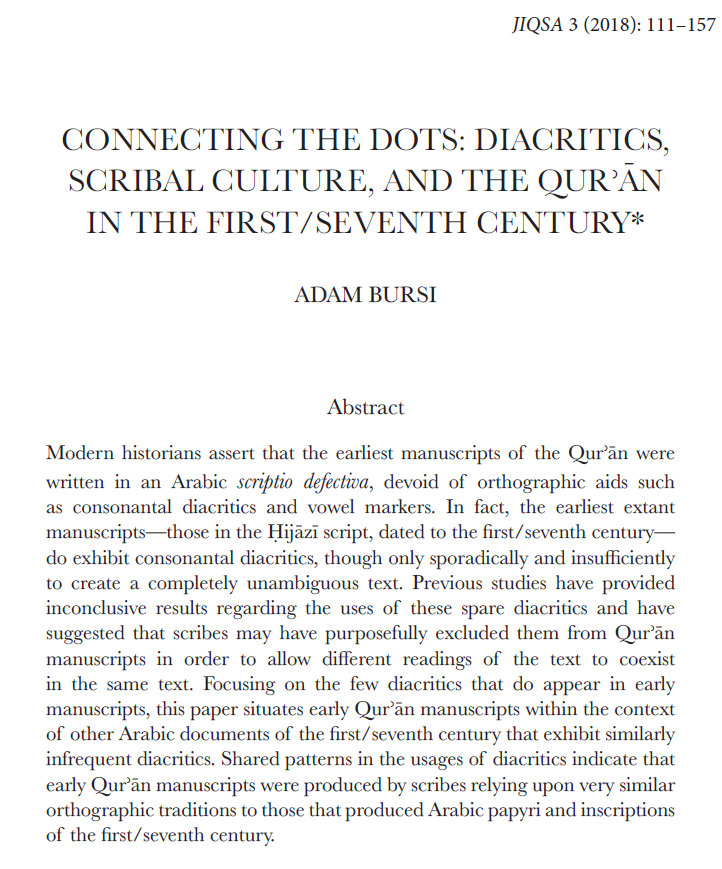
A fascinating and, likely, extremely early rendering of Sūrat al-ʾIḫlāṣ, both remarkable for its not-quite-canonical wording AND its pre-Islamic spelling practices.
A thread on what information can be gleaned from it 🧵
A thread on what information can be gleaned from it 🧵
https://twitter.com/DxqNXDiDbYvi3mL/status/1484257118073073672

The basmalah is unremarkable, but the first verse is different from from the canonical reading. Rather than:
qul huwa ḷḷāhu ʾaḥadun قول هو الله احد "He is Allah, the one" the text reads: الله لا احد, which, at first blush might look like it says: God, not one ?
qul huwa ḷḷāhu ʾaḥadun قول هو الله احد "He is Allah, the one" the text reads: الله لا احد, which, at first blush might look like it says: God, not one ?
Is this verse espousing an anti-monotheistic version of al-ʾIḫlāṣ? No. In pre-Islamic inscriptions, and occasionally in early Arabic manuscripts the asseverative particle la- before a word with a hamzah is, for some reason written with لا.
Those who know the orthography of modern mushafs well, will know that Q27:21 la-ʾaḏbaḥannahū is spelled لااذبحنه. This is the same practice. Those working from print copies from the Indian subcontinent might also know it from Q37:68 la-ʾilā. 



Surprisingly, our earliest manuscripts of Q27:21 actually DO NOT have the extra ʾalif.
1. British Library Or. 2165
2. Tübingen, Ma VI 165
3. Saray Medina 1a
4. Saray Medina 1b
But while the spelling is not archetypal for this specific word, it is frequently found in manuscripts.



1. British Library Or. 2165
2. Tübingen, Ma VI 165
3. Saray Medina 1a
4. Saray Medina 1b
But while the spelling is not archetypal for this specific word, it is frequently found in manuscripts.




For example:
Q20:71 fa-la-ʾuqaṭṭiʿanna in Saray Medina 1a
Q21:57 la-ʾakīdanna in Ma VI 165
Q38:85 la-ʾamlaʾanna in Or. 2165
And indeed even Q3:158 لاالى can be found in the Codex Parisino-Petropolitanus.
This unusual practice is also found in several pre-Islamic inscriptions.



Q20:71 fa-la-ʾuqaṭṭiʿanna in Saray Medina 1a
Q21:57 la-ʾakīdanna in Ma VI 165
Q38:85 la-ʾamlaʾanna in Or. 2165
And indeed even Q3:158 لاالى can be found in the Codex Parisino-Petropolitanus.
This unusual practice is also found in several pre-Islamic inscriptions.




It is seen frequently in a fairly common pre-islamic monotheistic formula: فلااوصكم ببريله fa-la-ʾuwaṣṣi-kum bi-birri llāh "So I certainly urge you towards piety in God" (or perhaps fa-la-ʾawṣā-kum "So he certainly urged you"?)
alsahra.org/wp-content/upl…
alsahra.org/wp-content/upl…

That was a long lead up to say that the first verse in the inscription should be read as aḷḷāhu la-ʾaḥadun "God is certainly One!"
That wording is a bit strange, you'd rather expect ʾinna ḷḷāha la-ʾaḥadun (compare ʾinna ḷḷāha la-samīʿun ʿalīmun), but this must be it.
That wording is a bit strange, you'd rather expect ʾinna ḷḷāha la-ʾaḥadun (compare ʾinna ḷḷāha la-samīʿun ʿalīmun), but this must be it.
The next remarkable feature is one is right in the next verse, which is spelled الله اصمد for ʾaḷḷāhu ṣ-ṣamadu. The assimilated definite article is spelled phonetically, with just an ʾalif and without the lām! Very unusual in Islamic era.
Finally the last verse is remarkable for several reasons. First, the author appears to have forgotten the negation, so the verse seems to say: "And he has an equal", oops!
But that aside there are still to other remarkable features...
But that aside there are still to other remarkable features...
First, the author wrote يكون yakūn, rather than يكن yakun, that is, the imperfective stem rather than the apocopate stem. In modern dialects these stems are merged completely, and this inscription might just anticipate such a development already this early!
The other strange feature is the spelling of kufuʾan "an equal", this word in the Quran (as are all other words) as if they did not contain a hamzah. The dominant reading tradition today also indeed recites it kufuwan, but the inscription write كفا, not the expected كفوا.
There are a couple of ways of interpreting that. ʾAbū Ḥayyān mentions transmissions of this verse with kufan (< *kufʾan) and kifāʾan, both readings would be consistent with the spelling here.
But there is yet another, exciting option, which suggests it DID write kufuʾan...
But there is yet another, exciting option, which suggests it DID write kufuʾan...

As mentioned, Quranic and Classical Arabic spell words as they would be pronounced if there was no hamzah (glottal stop). so kufuʾan is spelled as if kufuwan. This reflects the Hijazi pronunciation of Arabic.
But in pre-Islamic times, the hamzah usually WOULD be written.
But in pre-Islamic times, the hamzah usually WOULD be written.
In Nabataean inscriptions, but also in much later post-Nabataean inscriptions the ʾalif would be used to write hamzah. For example in this inscription from Ḥima (near Najran) the month name al-muʾtamar is spelled الماتمر!
So it may read kufuʾan with Nabataean hamzah spelling!


So it may read kufuʾan with Nabataean hamzah spelling!



All of these features taken together, had it not contained the Quran, would have motivated anyone working on pre-Islamic Arabic to have tentatively suggested that this inscription is pre-Islamic.
It seems that these ancient practices lived on into the early Islamic period.
It seems that these ancient practices lived on into the early Islamic period.
If you enjoyed this thread, and would like to support me and get exclusive access to my work-in-progress critical edition of the Quran, consider becoming a patron on patreon.com/PhDniX/!
You can also always buy me a coffee as a token of appreciation.
ko-fi.com/PhDniX/
You can also always buy me a coffee as a token of appreciation.
ko-fi.com/PhDniX/
• • •
Missing some Tweet in this thread? You can try to
force a refresh






















